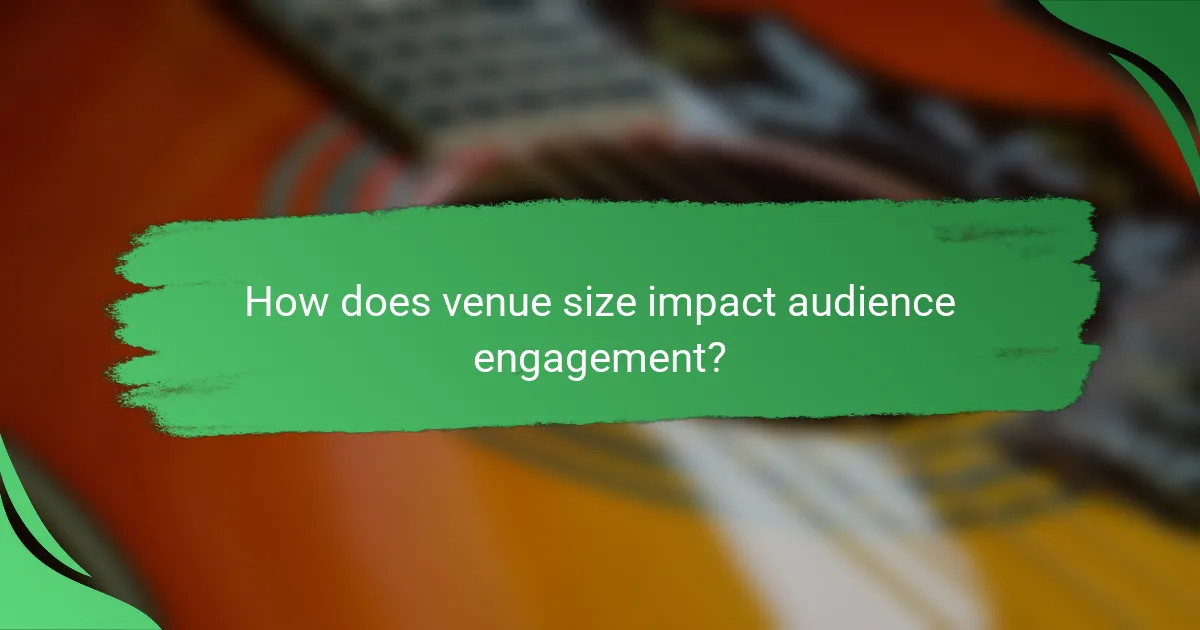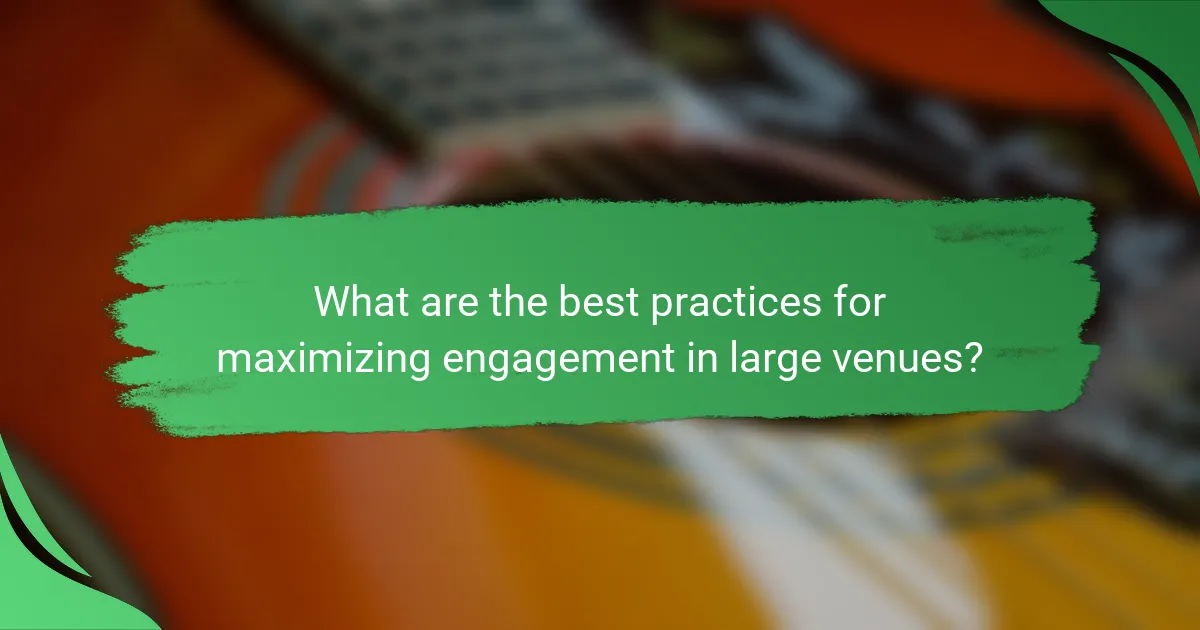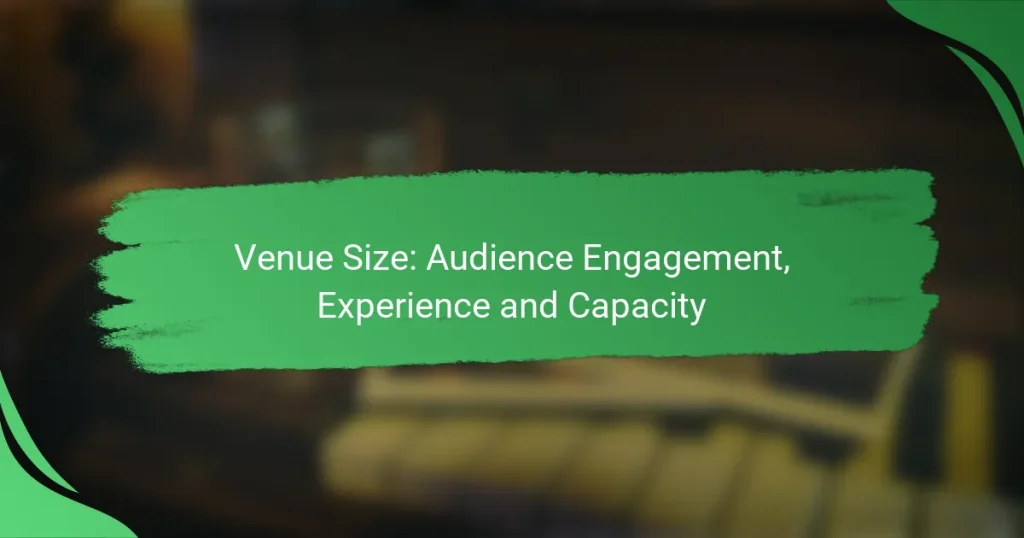Venue size plays a crucial role in shaping audience engagement and overall experience. Smaller venues often create a more intimate atmosphere that fosters personal connections, while larger spaces can evoke a sense of grandeur but may limit interaction. Selecting the right venue capacity is essential to ensure comfort and facilitate meaningful engagement among attendees.

How does venue size impact audience engagement?
Venue size significantly influences audience engagement by shaping the atmosphere, interaction levels, and overall experience. Smaller venues tend to foster intimacy and connection, while larger venues can create a sense of grandeur but may dilute personal interactions.
Optimal size for intimate experiences
Intimate venues, typically accommodating fewer than 200 attendees, enhance audience engagement through close proximity to performers and speakers. This setting allows for direct interaction, fostering a sense of community and personal connection. Examples include small theaters, art galleries, and private event spaces.
When planning an event aimed at creating intimate experiences, consider venues that allow for flexible seating arrangements and interactive elements, such as Q&A sessions or meet-and-greets. This encourages participation and makes attendees feel valued.
Large venues and crowd dynamics
Large venues, accommodating hundreds to thousands of participants, can create a powerful atmosphere but may challenge personal engagement. The sheer size can lead to a more generalized experience, where individual voices may be lost. However, large venues can also facilitate spectacular productions and performances that leave a lasting impression.
To enhance engagement in larger spaces, utilize technology such as large screens for visibility and sound systems for clarity. Consider incorporating interactive elements, like mobile apps for audience polling, to maintain connection despite the distance.
Case study: Madison Square Garden
Madison Square Garden, a renowned venue in New York City, exemplifies the dynamics of large venues. With a capacity of over 20,000, it hosts a variety of events, from concerts to sports, creating a unique atmosphere that blends excitement with the challenge of maintaining audience engagement.
The venue employs advanced technology, including high-definition screens and sophisticated sound systems, to enhance the experience. Additionally, they often incorporate fan engagement initiatives, such as interactive displays and social media integration, to bridge the gap between performers and the audience.

What is the ideal venue capacity for events?
The ideal venue capacity for events depends on the type of event, the desired atmosphere, and the expected audience size. Generally, it is best to choose a venue that comfortably accommodates attendees while allowing for engagement and interaction.
Factors influencing capacity decisions
Several factors influence decisions regarding venue capacity, including the nature of the event, layout requirements, and safety regulations. For example, a conference may require more space for seating and breakout sessions, while a concert might prioritize standing room.
Additionally, consider the audience’s comfort and engagement levels. A venue that is too large can create a disconnect, while one that is too small may lead to overcrowding. Aim for a balance that fosters interaction and maintains a welcoming environment.
Comparison of venue sizes for different events
Different events typically require different venue sizes. For instance, a small workshop may be effectively held in a space accommodating 20-50 people, while a corporate seminar might need a venue for 100-300 attendees. Larger events, such as concerts or trade shows, often require venues that can hold several hundred to thousands of participants.
When selecting a venue, consider not only the expected attendance but also the type of experience you want to create. For example, intimate gatherings benefit from smaller venues that enhance personal connections, while larger events can leverage bigger spaces for impressive setups and amenities.

How can venue layout enhance audience experience?
Venue layout plays a crucial role in enhancing audience experience by optimizing sightlines, comfort, and accessibility. A well-designed space not only improves engagement but also ensures that all attendees feel included and valued.
Seating arrangements and sightlines
Effective seating arrangements are essential for maximizing sightlines and ensuring that every audience member can see the stage or presentation area clearly. Consider tiered seating for larger venues, as it allows for better visibility, especially in auditoriums or concert halls.
When planning seating, maintain a balance between capacity and comfort. Aim for a minimum of 1 meter between rows to allow for easy movement, and ensure that seats are not too far from the stage, ideally within 30 meters for optimal engagement.
Accessibility features in venue design
Incorporating accessibility features into venue design is vital for accommodating all attendees, including those with disabilities. Ensure that there are designated wheelchair-accessible seats, ramps, and restrooms, complying with local regulations such as the Americans with Disabilities Act (ADA) in the United States.
Additionally, consider providing assistive listening devices and clear signage in large venues. This not only enhances the experience for individuals with hearing impairments but also benefits the entire audience by creating a more inclusive environment.

What are the best practices for maximizing engagement in large venues?
To maximize engagement in large venues, it is essential to leverage technology and implement effective strategies tailored to the audience’s size. This approach enhances interaction and ensures that attendees feel connected to the event, regardless of the venue’s capacity.
Use of technology for interaction
Utilizing technology can significantly boost interaction in large venues. Tools like live polling, Q&A apps, and social media integration allow attendees to participate actively, even from the back rows. For instance, platforms such as Slido or Mentimeter can facilitate real-time feedback and questions, making the audience feel involved.
Additionally, incorporating large screens or projection systems can help display audience responses and questions, fostering a sense of community. Consider using mobile apps that allow attendees to connect with each other and share experiences, enhancing networking opportunities.
Engagement strategies for large audiences
Effective engagement strategies for large audiences include breaking the audience into smaller groups for discussions or activities. This method encourages participation and allows for more personalized interactions. Facilitators can guide these smaller groups to ensure everyone has a voice.
Another strategy is to incorporate interactive elements such as gamification, where attendees earn points or rewards for participation. This can motivate audience members to engage more actively. Always remember to keep the content relevant and dynamic to maintain interest throughout the event.

How do different regions affect venue size preferences?
Venue size preferences vary significantly across regions due to cultural, economic, and demographic factors. Understanding these regional differences can help event organizers select the most suitable venue for their audience and maximize engagement.
Regional trends in venue selection
In urban areas, larger venues often dominate due to higher population density and demand for large-scale events. For instance, cities like New York and London favor venues that can accommodate thousands, while smaller towns may prefer intimate settings that hold a few hundred attendees.
Economic factors also play a role; regions with higher disposable income may support larger venues and ticket prices, while areas with lower income levels might lean towards smaller, more affordable options. Additionally, cultural preferences influence venue size, with some regions favoring festivals and large gatherings, while others prioritize smaller, community-focused events.
Case study: Concerts in Los Angeles vs. Nashville
Los Angeles, known for its entertainment industry, typically features larger venues that can host thousands of fans, such as the Staples Center or the Hollywood Bowl. These venues cater to high-profile artists and large audiences, reflecting the city’s vibrant music scene.
In contrast, Nashville, often dubbed the “Music City,” has a rich tradition of live music in smaller, more intimate settings like the Ryman Auditorium or local honky-tonks. These venues foster close connections between artists and audiences, appealing to the city’s unique cultural identity.
When planning events in these cities, consider the local audience’s preferences; larger venues in Los Angeles may sell out quickly, while Nashville’s smaller venues might offer a more personal experience, attracting fans who appreciate the artistry and connection of live performances.

What are the key metrics for measuring audience engagement?
Key metrics for measuring audience engagement include participation rates, feedback quality, and interaction frequency. These metrics help assess how actively an audience is involved and how effectively they connect with the content or experience provided.
Surveys and feedback mechanisms
Surveys and feedback mechanisms are essential tools for gauging audience engagement. They can take various forms, such as online questionnaires, post-event polls, or live feedback sessions. Aim for a response rate of at least 20-30% to ensure the data is representative.
When designing surveys, focus on clear, concise questions that encourage honest responses. Use a mix of quantitative questions (like rating scales) and qualitative questions (open-ended responses) to capture a comprehensive view of audience sentiment.
Data analytics for engagement tracking
Data analytics plays a crucial role in tracking audience engagement by providing insights into behavior patterns and preferences. Tools like Google Analytics or social media insights can help measure metrics such as page views, session duration, and interaction rates. Regularly review this data to identify trends and areas for improvement.
Consider setting up key performance indicators (KPIs) tailored to your specific goals, such as increasing social media shares or improving event attendance. By analyzing these metrics, you can make informed decisions to enhance audience engagement strategies effectively.


